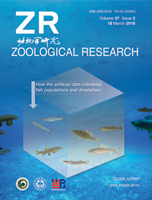
|
Zoological Research
Kunming Institute of Zoology, Chinese Academy of Sciences
ISSN: 2095-8137
Vol. 42, No. 2, 2021, pp. 161-169
|
 Bioline Code: zr21019
Bioline Code: zr21019
Full paper language: English
Document type: Research Article
Document available free of charge
|
|
|
Zoological Research, Vol. 42, No. 2, 2021, pp. 161-169
| en |
Lower respiratory tract samples are reliable for severe acute respiratory syndrome coronavirus 2 nucleic acid diagnosis and animal model study
Tian, Ren-Rong; Yang, Cui-Xian; Zhang, Mi; Feng, Xiao-Li; Luo, Rong-Hua; Duan, Zi-Lei; Li, Jian-Jian; Liu, Jia-Fa; Yu, Dan-Dan; Xu, Ling; Zheng, Hong-Yi; Li, Ming-Hua; Fan, Hong-Li; Wang, Jia-Li; Dong, Xing-Qi & Zheng, Yong-Tang
Abstract
Severe acute respiratory syndrome coronavirus 2 (SARS-CoV-2) and coronavirus disease 2019 (COVID-19) continue to impact countries worldwide. At present, inadequate diagnosis and unreliable evaluation systems hinder the implementation and development of effective prevention and treatment strategies. Here, we conducted a horizontal and longitudinal study comparing the detection rates of SARS-CoV-2 nucleic acid in different types of samples collected from COVID-19 patients and SARS-CoV-2-infected monkeys. We also detected anti-SARS-CoV-2 antibodies in the above clinical and animal model samples to identify a reliable approach for the accurate diagnosis of SARS-CoV-2 infection. Results showed that, regardless of clinical symptoms, the highest detection levels of viral nucleic acid were found in sputum and tracheal brush samples, resulting in a high and stable diagnosis rate. Anti-SARS-CoV-2 immunoglobulin M (IgM) and G (IgG) antibodies were not detected in 6.90% of COVID-19 patients. Furthermore, integration of nucleic acid detection results from the various sample types did not improve the diagnosis rate. Moreover, dynamic changes in SARS-CoV-2 viral load were more obvious in sputum and tracheal brushes than in nasal and throat swabs. Thus, SARS-CoV-2 nucleic acid detection in sputum and tracheal brushes was the least affected by infection route, disease progression, and individual differences. Therefore, SARS-CoV-2 nucleic acid detection using lower respiratory tract samples alone is reliable for COVID-19 diagnosis and study.
Keywords
COVID-19; SARS-CoV-2; Diagnosis; Animal model
|
| |
© Copyright 2021 - Editorial Office of Zoological Research, Kunming Institute of Zoology, Chinese Academy of Sciences
Alternative site location: http://www.zoores.ac.cn/
|
|
